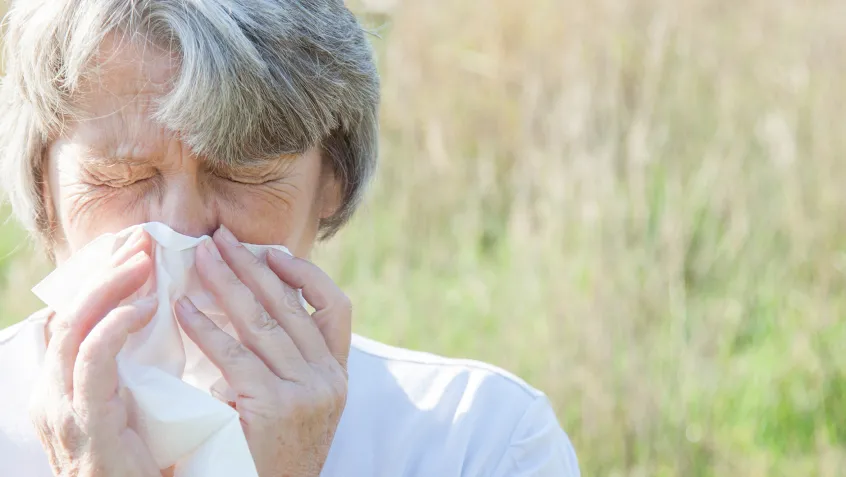
Spring is (almost) in the air. And you know what that means—allergies are on the rise.
Seasonal allergic rhinitis, commonly known as hay fever, is caused by pollen in the air during different times of the year depending on where you live. The Centers for Disease Control and Prevention (CDC) estimates that 60 million people experience hay fever symptoms each year in the United States.
Pollen is a powdery substance released by flowering trees, weeds, and grasses as part of their reproductive process. For many places in the United States, tree pollen season begins in March. Certain species of trees including birch, cedar, and oak produce highly allergenic pollen.
What Are Allergies?
Allergies are one of the most common chronic health conditions worldwide. These allergic reactions result when your immune system overreacts to an allergen by producing antibodies that release histamine and other chemicals.
Common symptoms of allergies include:
- Runny nose
- Sneezing
- Itchy ears, eyes, mouth, and nose
- Red, watery eyes
- Swelling around eyes
If you experience these symptoms, your healthcare provider can diagnose a pollen allergy using a skin prick test or a blood test. Some over-the-counter or prescription medicines can help reduce symptoms.
Pollen and Asthma Triggers
Asthma is a chronic illness that affects roughly 25 million Americans each year. It affects the airways in the lungs, often making it hard to breathe.
An asthma attack can happen when you are exposed to asthma triggers, which can potentially include pollen. If you have asthma, it is important to know your triggers and learn how to avoid them.
Asthma is considered the most common chronic medical condition in pediatrics. NEEF launched an eLearning program in May 2020 to help pediatric healthcare providers and clinicians manage environmental asthma triggers and intervention strategies.
Healthcare providers completing NEEF's Environmental Management of Pediatric Asthma online course will be better equipped to help the 5.5 million children in the US affected by asthma manage their symptoms. This will become even more important as we face increasing pollen counts, longer pollen seasons, and reduced air quality due to climate change.
Changing Climate, Changing Pollen Seasons
The CDC warns that our changing climate means more frost-free days, warmer seasonal air temperatures, and more CO2 in the atmosphere. These changes have a direct impact on when and how much pollen is in the air and how it impacts human health.
Today, many plants and trees are blooming earlier than they did over the past century due to milder winters and earlier spring thaws. A 2020 study found that in North America there is now 21% more pollen in the air on average 20 days earlier each year compared to 1990.
Earlier, harsher allergy seasons can bring serious health impacts, including increased risk of hospitalization for those with asthma and making it harder for kids to learn at school.
12 Tips to Prepare for Pollen Season
If you often experience hay fever or asthma symptoms, follow these tips to prepare for pollen season.
- Check the current pollen levels in your area using the American Academy of Allergy, Asthma & Immunology’s National Allergy Bureau interactive map and email alerts.
- Plan to spend less time outdoors when pollen levels will be high.
- Wear sunglasses and a hat when outdoors to help defend against pollen in your eyes or hair.
- Don’t touch your eyes when you are outside.
- Wash your hands after being outside.
- Change your clothes after being outdoors and shower to remove pollen from your skin and hair.
- Wash bedding in hot, soapy water once a week.
- Use a clothes dryer rather than an outdoor clothesline.
- Keep windows closed during pollen season.
- Use high-efficiency filters in your home’s heating, ventilation, and air conditioning (HVAC) system.
- Learn more about how to reduce indoor pollution sources, improve ventilation, and lower the concentrations of indoor air pollutants on EPA’s Improving Indoor Air Quality web site.
- Follow the Asthma and Allergy Foundation of America’s advice to start taking allergy medication before pollen season begins. This allows the medicine to prevent your body from releasing histamine and other chemicals that cause the symptoms.
Updated Air Quality and Pollen Information
Knowing the current air quality and pollen conditions can help you prepare for outdoor activities. AirNow.gov provides current and forecast air quality maps and data for more than 500 cities across the U.S., and you can find the pollen count in your zip code at Pollen.com.
NEEF Tools to Manage Asthma
NEEF offers free tools and training to help healthcare professionals and caretakers identify and manage pediatric asthma triggers. Visit our asthma resources page for more information


